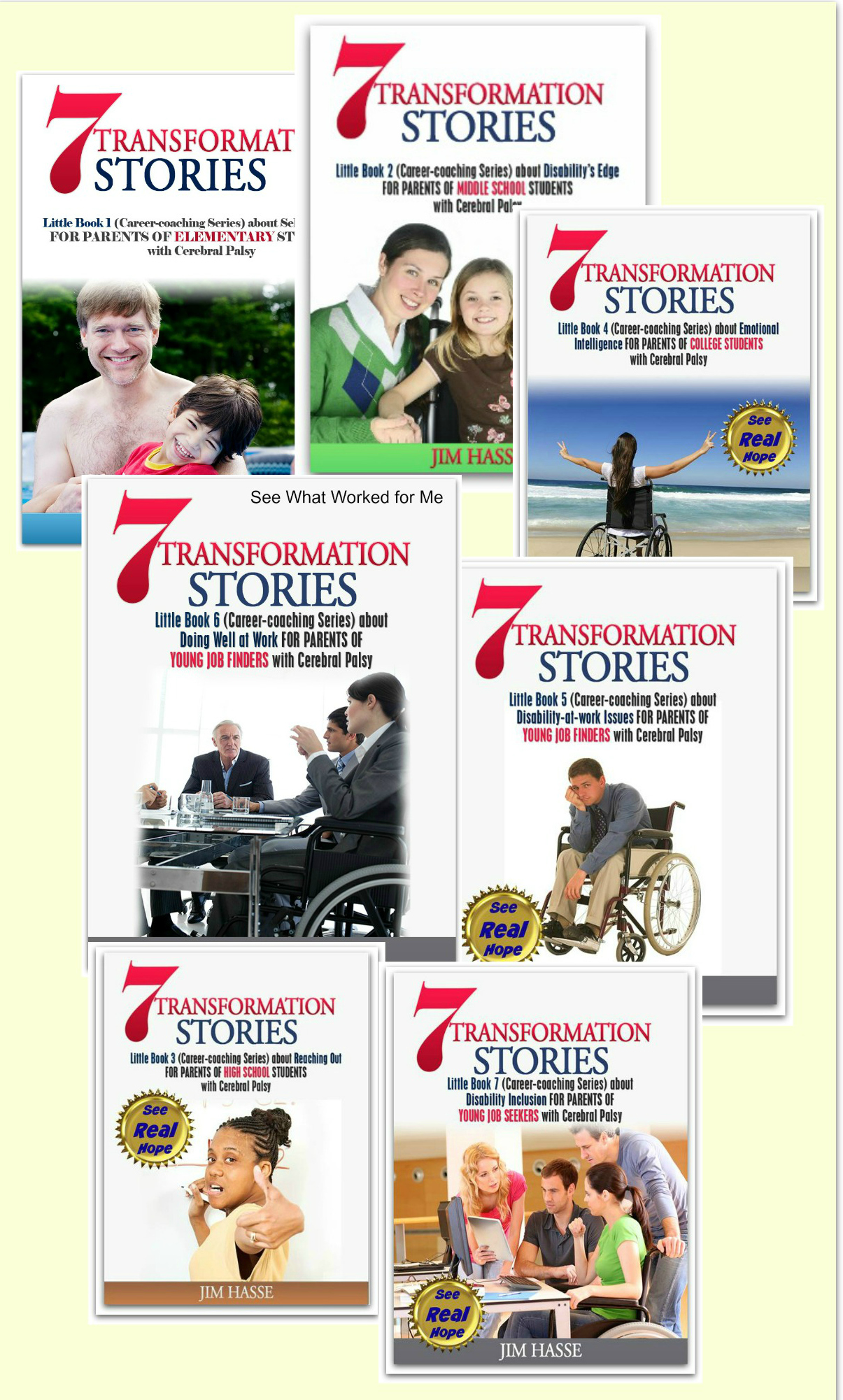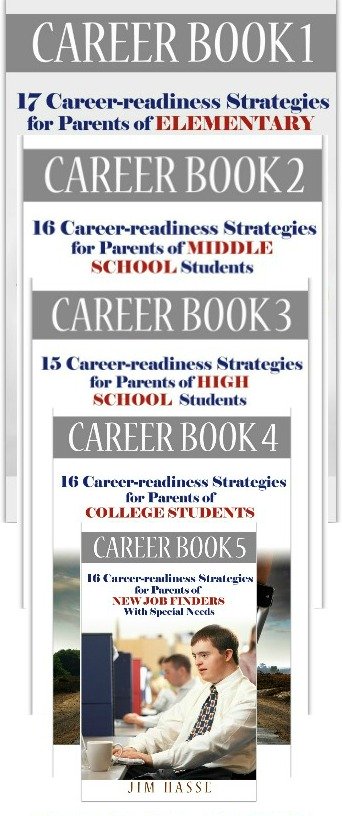Example of Personal Development: Cerebral Palsy Career Builder for Job Seekers
By Jim Hasse, ABC, GCDF, Disability Employment Expert
_________________________________________________________
Here’s one example of personal development: Encourage your new job seeker with cerebral palsy (CP) to form a “mastermind” group for learning how to tap personal strengths and overcome barriers.
Each individual (disabled or not) has strengths to tap and barriers to overcome when it comes to the task of finding meaningful work after formal education has ended.
But, there’s an odd twist to that generally accepted statement. By ourselves, we often find it difficult to pinpoint what our strengths and weaknesses really are -- even if we think we know ourselves quite well.
Disability is a good example of how we can sometimes fool ourselves about what is “normal,” for instance. As a person with CP, I may think (and feel) that my back is straight, but I need to look in a mirror to realize that it’s a little off center due to a slight curvature in my spine. What I experience and what is real don’t always match.
Your young job seeker needs an example of personal development – how to see a true reflection of his or herself (like looking in a mirror). Your son or daughter can then take advantage of his or her strengths and work around (not necessarily overcome or eliminate) barriers.
One way to do that is to get honest feedback from others who have your job seeker’s best interests at heart.
That’s where GettingHired.com can help. By working together with one or two friends, a career coach or a mentor within the GettingHired.com community who are relatively close to your young job seeker geographically, your son or daughter can bolster his or confidence and learn things about his or herself that were previously hidden. It’s an example of personal development in action.
Even if the others in that small group don't know your son or daughter, having to explain what he or she means by a strength is a good exercise and a good example of personal development in action because, by just sharing thoughts, he or she will begin to find the answers for putting a job marketing campaign on a sound track.
Working alone in trying to
find a job, your job seeker may just not recognize those answers that have
always been there for him or her.

“Mastermind”: Example of personal development
This is a self-help approach. As a parent, coach or mentor, you can’t carry out this example of personal development for your new job seeker. He or she needs to come up with a personal analysis about how to become a more engaging job candidate. Employers hire individuals they personally like.
So, encourage your son or daughter to form a small group in which each participant can face each other, preferably in person, and collaborate on finding answers to key questions related to a job search. Those key questions should ask “what,” “how,” “when” and “who” (in other words, behavior: “What’s the evidence?”) -- but not “why.”
If your job seeker’s group can’t meet in person, it
can meet regularly through telephone conferences, Skype, instant messaging,
private forums etc.
When has your youngster received
personal-development help
from someone outside your family?
Join PACER’s Facebook
discussion
At any rate, the group should ideally consist of three people (including your son or daughter) who are willing to mentor and support one another -- all with one purpose: find meaningful work. Exploring the “mastermind” guidelines may be helpful.
Within the “mastermind” framework, encourage your new job seeker to follow the following template – an example of personal development for evaluating strengths and weaknesses from a job-hunting perspective.
Step One: List your strengths as a job seeker
Using pen and paper, a computer, or whatever medium is easiest for you, create a list of strengths you already have that you find useful in seeking a job. Don't censor yourself. Follow your first instincts.
Examples: "Extensive online network; social media savvy; ability to communicate well on paper, online, and in person; public speaking experience; online and in-person facilitator experience; strategic thinker."
Step Two: Choose the most critical strengths you offer an employer
Look at your list and choose the three most important strengths you have identified.
Example: "Writing, networking, facilitating."
Step Three: Develop a statement about your strengths as a job seeker
Using the present tense, compose a statement that describes your strengths as if you were trying to convince a prospective employer that you are on top of your game as a job seeker.
Example: “I develop key connections online within my field because I know how to network effectively (communicate, facilitate, reciprocate).”
Step Four: Find ways you can make your strengths even better
For each item, spend some time thinking how you can develop your strengths even more.
Example: “Since I’m personable and meet people
easily, I need to become more visible in person to potential employers through
volunteer work and in-person networking events.”
Set the notes above aside for now. The next four
steps are exactly the same as the first four, but instead of discussing your
strengths and how to describe and improve them, think of the weaknesses
(barriers) you face and how you can minimize or work around them.
Step Five: List your barriers as a job seeker
Create a list of your barriers (both in terms of your career development as well as your CP) that are blocking your job search. Don't censor yourself, but follow your first instincts.
Examples: "Procrastination; low attention to detail; low interest in helping prospective employers ramp up for assistive technology I may require at my work station; reluctance to travel independently; low preference for hands-on work."
Step Six: Choose the key barriers which hold you back as a job seeker
Look at your barrier list. Choose the three key barriers you identified above that will most likely have the greatest impact on your success as a job seeker.
Example: "Responsibility for assistive technology, avoidance of hands-on work, reluctance to travel independently."
Step Seven: Write a statement describing your key barriers
Compose a statement that includes these weaknesses as if you were trying to talk someone out of hiring you for a job. Say "I won't" instead of "I can't".
Example: "I won't help you as my employer find assistive technology and travel solutions that I need because I dread getting involved in those details and having to work on it myself.”
Step Eight: Find ways to minimize or eliminate your key barriers
For each item, spend some time thinking about how you can minimize, work around or even eliminate these barriers so you can no longer make your barrier statement (above) truthfully.
Example: "Find a person in my online network who can mentor me about how to work out the details with an employer to obtain the workplace accommodations I need."
Example: "Use my network to locate a person with a similar disability who has learned to travel independently and who is willing to coach me step by step in doing the same."
Step Nine: Decide what would have the greatest impact
Take a look at your two lists and decide which strengths you most need to focus on and which weaknesses are the greatest threat to your success as job seeker.
Example: "Diversifying my networking efforts and becoming an expert about the personal workplace accommodations I need will have the greatest impact on the success of my job seeking initiative."
Step Ten: Set a date to get stronger
Sit down with your planner and set appointments with yourself to take those first steps towards a better, more successful you!
Example: "Next Tuesday, submit a question on LinkedIn about what it takes to travel independently with my particular disability."
Do you see how following this example of personal development can help your new job seeker build a sense of self-confidence and an appreciation for lifelong learning?
I find the best part of this example of personal development is that, once a current goal is accomplished, it’s time to start all over on a new goal. Lifelong learning (with the help of others) is, after all, both a joy and a necessity in today’s economy.
When has your youngster received
personal-development help
from someone outside your family?
Join PACER’s Facebook
discussion
Return from Example of
Personal Development to Job Finder
Go to Cerebral Palsy
Career Builders
This is Creative Commons content. You can freely and legally use, share and repurpose it for non-commercial purposes only, provided you attach this sentence and the following attribution to it (including the two links):
Originally written and illustrated by Jim Hasse, ABC, GCDF, owner of Hasse Communication Counseling, LLC, who, as a person with cerebral palsy, served for 10 years as a vice president in a Fortune 500 company during his 29-year career in corporate communication. He’s an Accredited Business Communicator, certified as a Global Career Development Facilitator and author of 14 Amazon books about disability awareness and disability employment issues.





